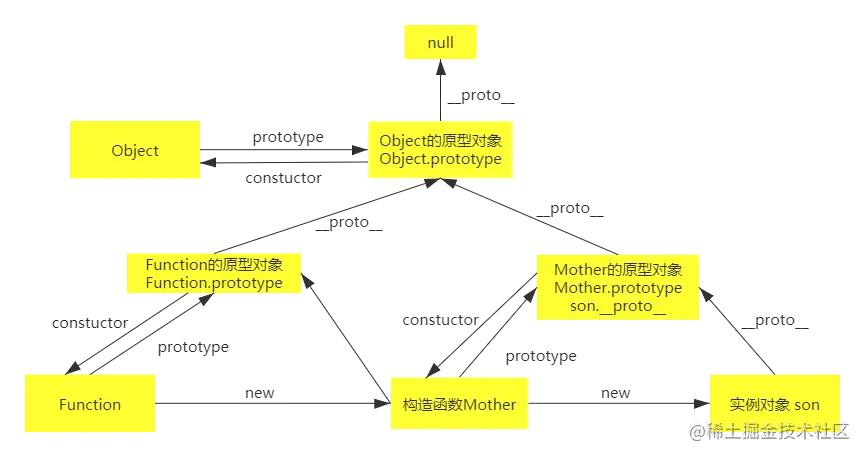一、前言
在面试过程中,频频被原型相关知识问住,每次回答都支支吾吾。后来有家非常心仪的公司,在二面时,果不其然,又问原型了!
我痛下决心用了两天时间钻研了下原型,弄明白后发现世界都明亮了,原来这么简单 ~
有些理解还比较浅薄,随着时间的推移和理解的深入,以后还会补充。如果大家发现我理解的有问题,欢迎大家在评论中指正。话不多说,切入正题。
二、构造函数
讲原型则离不开构造函数,让我们先来认识下构造函数。
2.1 构造函数分为 实例成员 和 静态成员
让我们先来看看他们分别是什么样子的。
实例成员: 实例成员就是在构造函数内部,通过this添加的成员。实例成员只能通过实例化的对象来访问。
静态成员: 在构造函数本身上添加的成员,只能通过构造函数来访问
function Star(name,age) {
//实例成员
this.name = name;
this.age = age;
}
//静态成员
Star.sex = '女';
let stars = new Star('小红',18);
console.log(stars); // Star {name: "小红", age: 18}
console.log(stars.sex); // undefined 实例无法访问sex属性
console.log(Star.name); //Star 通过构造函数无法直接访问实例成员
console.log(Star.sex); //女 通过构造函数可直接访问静态成员
2.2 通过构造函数创建对象
该过程也称作实例化
2.2.1 如何通过构造函数创建一个对象?
function Father(name) {
this.name = name;
}
let son = new Father('Lisa');
console.log(son); //Father {name: "Lisa"}
此时,son就是一个新对象。
2.2.2 new一个新对象的过程,发生了什么?
(1) 创建一个空对象 son {}
(2) 为 son 准备原型链连接 son.__proto__ = Father.prototype
(3) 重新绑定this,使构造函数的this指向新对象 Father.call(this)
(4) 为新对象属性赋值 son.name
(5) 返回this return this,此时的新对象就拥有了构造函数的方法和属性了
2.2.3 每个实例的方法是共享的吗?
这要看我们如何定义该方法了,分为两种情况。
方法1:在构造函数上直接定义方法(不共享)
function Star() {
this.sing = function () {
console.log('我爱唱歌');
}
}
let stu1 = new Star();
let stu2 = new Star();
stu1.sing();//我爱唱歌
stu2.sing();//我爱唱歌
console.log(stu1.sing === stu2.sing);//false
很明显,stu1 和 stu2 指向的不是一个地方。
所以 在构造函数上通过this来添加方法的方式来生成实例,每次生成实例,都是新开辟一个内存空间存方法。这样会导致内存的极大浪费,从而影响性能。
方法2:通过原型添加方法(共享)
构造函数通过原型分配的函数,是所有对象共享的。
function Star(name) {
this.name = name;
}
Star.prototype.sing = function () {
console.log('我爱唱歌', this.name);
};
let stu1 = new Star('小红');
let stu2 = new Star('小蓝');
stu1.sing();//我爱唱歌 小红
stu2.sing();//我爱唱歌 小蓝
console.log(stu1.sing === stu2.sing);//true
2.2.4 实例的属性为基本类型是,它们是共享的吗?
属性存储的是如果存储的是基本类型,不存在共享问题,是否相同要看值内容。
let stu1 = new Star('小红');
let stu2 = new Star('小红');
console.log(stu1.name === stu2.name);//true
let stu1 = new Star('小红');
let stu2 = new Star('小蓝');
console.log(stu1.name === stu2.name);//false
2.2.5 定义构造函数的规则
公共属性定义到构造函数里面,公共方法我们放到原型对象身上。
三、原型
前面我们在 实例化 和 实例共享方法 时,都提到了原型。那么现在聊聊这个神秘的原型到底是什么?
3.1 什么是原型?
Father.prototype 就是原型,它是一个对象,我们也称它为原型对象。
3.2 原型的作用是什么?
原型的作用,就是共享方法。
我们通过 Father.prototype.method 可以共享方法,不会反应开辟空间存储方法。
3.3 原型中this的指向是什么?
原型中this的指向是实例。
四、原型链
4.1 什么是原型链?
原型与原型层层相链接的过程即为原型链。
4.2 原型链应用
对象可以使用构造函数prototype原型对象的属性和方法,就是因为对象有__proto__原型的存在
每个对象都有__proto__原型的存在
参考 前端进阶面试题详细解答
function Star(name,age) {
this.name = name;
this.age = age;
}
Star.prototype.dance = function(){
console.log('我在跳舞',this.name);
};
let obj = new Star('张萌',18);
console.log(obj.__proto__ === Star.prototype);//true
4.3 原型链图

4.4 原型查找方式
例如:查找obj的dance方法
function Star(name) {
this.name = name;
(1)首先看obj对象身上是否有dance方法,如果有,则执行对象身上的方法
this.dance = function () {
console.log(this.name + '1');
}
}
(2)如果没有dance方法,就去构造函数原型对象prototype身上去查找dance这个方法。
Star.prototype.dance = function () {
console.log(this.name + '2');
};
(3)如果再没有dance方法,就去Object原型对象prototype身上去查找dance这个方法。
Object.prototype.dance = function () {
console.log(this.name + '3');
};
(4)如果再没有,则会报错。
let obj = new Star('小红');
obj.dance();
(1)首先看obj对象身上是否有dance方法,如果有,则执行对象身上的方法。
(2)如果没有dance方法,就去构造函数原型对象prototype身上去查找dance这个方法。
(3)如果再没有dance方法,就去Object原型对象prototype身上去查找dance这个方法。
(4)如果再没有,则会报错。
4.5 原型的构造器
原型的构造器指向构造函数。
function Star(name) {
this.name = name;
}
let obj = new Star('小红');
console.log(Star.prototype.constructor === Star);//true
console.log(obj.__proto__.constructor === Star); //true
4.5.1 在原型上添加方法需要注意的地方
方法1:构造函数.prototype.方法在原型对象上直接添加方法,此时的原型对象是有constructor构造器的,构造器指向构造函数本身
function Star(name) {
this.name = name;
}
Star.prototype.dance = function () {
console.log(this.name);
};
let obj = new Star('小红');
console.log(obj.__proto__); //{dance: ƒ, constructor: ƒ}
console.log(obj.__proto__.constructor); // Star
方法2:Star.prototype = {}给原型重新赋值,此时会丢失构造器,我们需要手动定义构造器,指回构造函数本身
function Star(name) {
this.name = name;
}
Star.prototype = {
dance: function () {
console.log(this.name);
}
};
let obj = new Star('小红');
console.log(obj.__proto__); //{dance: ƒ}
console.log(obj.__proto__.constructor); // ƒ Object() { [native code] }
Star.prototype.constructor = Star;
4.5.2 一般不允许直接改变原型prototype指向
改变原型指向,会使原生的方法都没了,所以Array、String这些内置的方法是不允许改变原型指向的。如果改变了,就会报错。
Array.prototype.getSum = function (arr) {
let sum = 0;
for (let i = 0; i < this.length; ++i) {
sum += this[i];
}
return sum;
};
let arr = [1, 2, 3, 4, 5, 6, 7, 8, 9];
console.log(arr.getSum());//45
如果改变prototype指向,会报错!
Array.prototype = {
getSum: function (arr) {
let sum = 0;
for (let i = 0; i < this.length; ++i) {
sum += this[i];
}
return sum;
}
};
let arr = [1, 2, 3, 4, 5, 6, 7, 8, 9];
console.log(arr.getSum());//45

五、继承 - ES5方法
ES6之前并没有给我们提供extends继承,我们可以通过构造函数+原型对象模拟实现继承。
继承属性,利用call改变this指向。但该方法只可以继承属性,实例不可以使用父类的方法。
function Father(name) {
this.name = name;
}
Father.prototype.dance = function () {
console.log('I am dancing');
};
function Son(name, age) {
Father.call(this, name);
this.age = age;
}
let son = new Son('小红', 100);
son.dance(); //报错
如何继承父类的方法呢?
解决方法1:利用Son.prototype = Father.prototype改变原型指向,但此时我们给子类增加原型方法,同样会影响到父类。
function Father(name) {
this.name = name;
}
Father.prototype.dance = function () {
console.log('I am dancing');
};
function Son(name, age) {
Father.call(this, name);
this.age = age;
}
Son.prototype = Father.prototype;
//为子类添加方法
Son.prototype.sing = function () {
console.log('I am singing');
};
let son = new Son('小红', 100);
//此时父类也被影响了
console.log(Father.prototype) //{dance: ƒ, sing: ƒ, constructor: ƒ}
解决方法2:子类的原型指向父类的实例,这样就可以顺着原型链共享父类的方法了。并且为子类添加原型方法的时候,不会影响父类。
function Father(name) {
this.name = name;
}
Father.prototype.dance = function () {
console.log('I am dancing');
};
function Son(name, age) {
Father.call(this, name);
this.age = age;
}
Son.prototype = new Father();
Son.prototype.sing = function () {
console.log('I am singing');
};
let son = new Son('小红', 100);
console.log(Father.prototype) //{dance: ƒ, constructor: ƒ}

七、类
什么是类?
类的本质还是一个函数,类就是构造函数的另一种写法。
function Star(){}
console.log(typeof Star); //function
class Star {}
console.log(typeof Star); //function
ES6中类没有变量提升
通过构造函数创建实例,是可以变量提升的。
es6中的类,必须先有类,才可以实例化。
类的所有方法都定义在类的prototype属性上面
让我们来测试一下。
class Father{
constructor(name){
this.name = name;
}
sing(){
return this.name;
}
}
let red = new Father('小红');
let green = new Father('小绿');
console.log(red.sing === green.sing); //true
向类中添加方法
通过Object.assign,在原型上追加方法。
class Father{
constructor(name){
this.name = name;
}
sing(){
return this.name;
}
}
//在原型上追加方法
Object.assign(Father.prototype,{
dance(){
return '我爱跳舞';
}
});
let red = new Father('小红');
let green = new Father('小绿');
console.log(red.dance());//我爱跳舞
console.log(red.dance === green.dance); //true
constructor方法
constructor方法是类的默认方法,通过new命令生成对象实例时,自动调用该方法。一个类必须有constructor方法,如果没有显式定义,一个空的constructor方法会被默认添加。
八、继承 - ES6方法
class Father {
constructor(name){
this.name = name;
}
dance(){
return '我在跳舞';
}
}
class Son extends Father{
constructor(name,score){
super(name);
this.score = score;
}
sing(){
return this.name +','+this.dance();
}
}
let obj = new Son('小红',100);
九、类和构造函数的区别
(1) 类必须使用new调用,否则会报错。这是它跟普通构造函数的一个主要区别,后者不用new也可以执行。
(2) 类的所有实例共享一个原型对象。
(3) 类的内部,默认就是严格模式,所以不需要使用use strict指定运行模式。
十、总结
构造函数特点:
1.构造函数有原型对象prototype。
2.构造函数原型对象prototype里面有constructor,指向构造函数本身。
3.构造函数可以通过原型对象添加方法。
4.构造函数创建的实例对象有__proto__原型,指向构造函数的原型对象。
类:
1.class本质还是function
2.类的所有方法都定义在类的prototype属性上
3.类创建的实例,里面也有__proto__指向类的prototype原型对象
4.新的class写法,只是让对象原型的写法更加清晰,更像面向对象编程的语法而已。
5.ES6的类其实就是语法糖。
十一、什么是语法糖
什么是语法糖?加糖后的代码功能与加糖前保持一致,糖在不改变其所在位置的语法结构的前提下,实现了运行时的等价。
语法糖没有改变语言功能,但增加了程序员的可读性。
十二、面试题分享
面试题1
Object.prototype.__proto__ //null
Function.prototype.__proto__ //Object.prototype
Object.__proto__ //Function.prototype
讲解:
这里涉及到Function的原型问题,附一张图,这图是一个面试官发给我的,我也不知道原作者在哪里~

面试题2
给大家分享那道我被卡住的面试题,希望大家在学习完知识后,可以回顾一下。
按照如下要求实现Person 和 Student 对象
a)Student 继承Person
b)Person 包含一个实例变量 name, 包含一个方法 printName
c)Student 包含一个实例变量 score, 包含一个实例方法printScore
d)所有Person和Student对象之间共享一个方法
es6类写法
class Person {
constructor(name) {
this.name = name;
}
printName() {
console.log('This is printName');
}
commonMethods(){
console.log('我是共享方法');
}
}
class Student extends Person {
constructor(name, score) {
super(name);
this.score = score;
}
printScore() {
console.log('This is printScore');
}
}
let stu = new Student('小红');
let person = new Person('小紫');
console.log(stu.commonMethods===person.commonMethods);//true
原生写法
function Person (name){
this.name = name;
this.printName=function() {
console.log('This is printName');
};
}
Person.prototype.commonMethods=function(){
console.log('我是共享方法');
};
function Student(name, score) {
Person.call(this,name);
this.score = score;
this.printScore=function() {
console.log('This is printScore');
}
}
Student.prototype = new Person();
let person = new Person('小紫',80);
let stu = new Student('小红',100);
console.log(stu.printName===person.printName);//false
console.log(stu.commonMethods===person.commonMethods);//true




 本文详细介绍了JavaScript中的构造函数、原型和原型链的概念,包括实例成员和静态成员、对象的创建过程、方法的共享以及实例属性的基本类型共享情况。同时,文章探讨了原型的作用、原型链的查找方式以及构造器的指向。此外,还讨论了ES5和ES6中的继承实现方式,以及类的特性。最后,文章通过面试题的形式巩固了所学知识。
本文详细介绍了JavaScript中的构造函数、原型和原型链的概念,包括实例成员和静态成员、对象的创建过程、方法的共享以及实例属性的基本类型共享情况。同时,文章探讨了原型的作用、原型链的查找方式以及构造器的指向。此外,还讨论了ES5和ES6中的继承实现方式,以及类的特性。最后,文章通过面试题的形式巩固了所学知识。
















 333
333

 被折叠的 条评论
为什么被折叠?
被折叠的 条评论
为什么被折叠?








